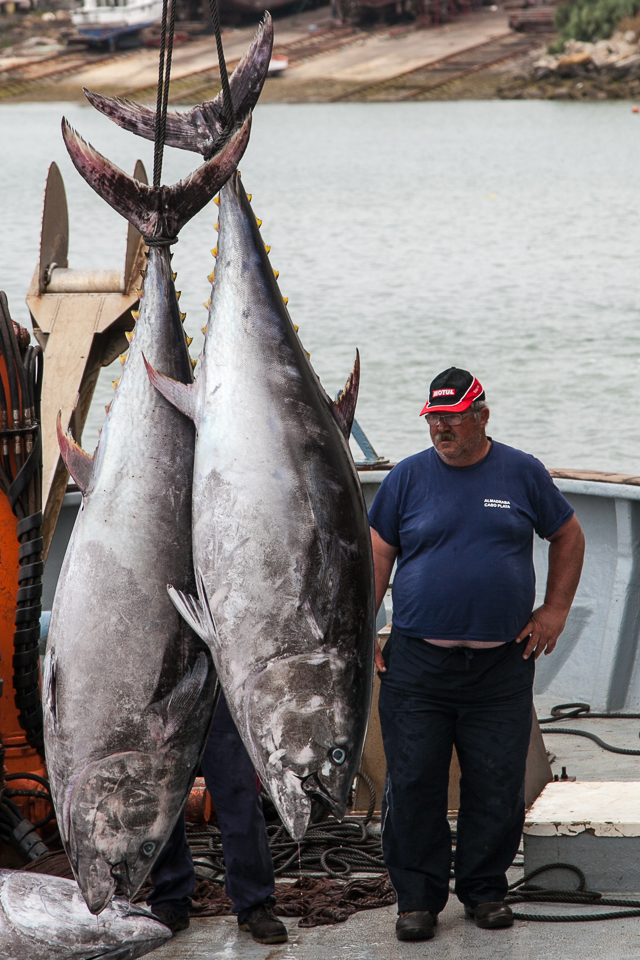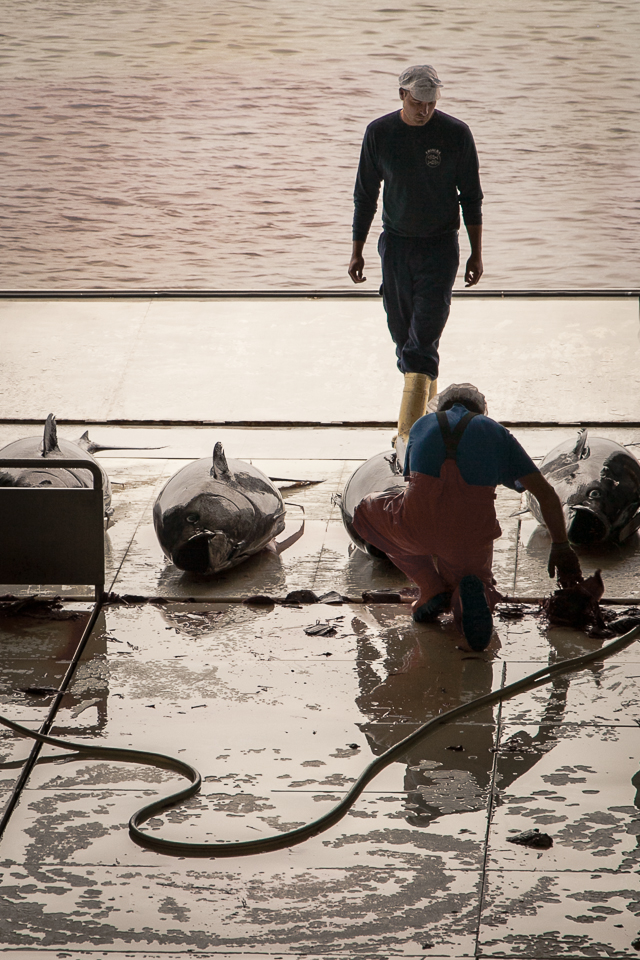
Apologies to vegans and vegetarians. This one is probably not for you. However, I have been writing this blog for well over a year now and I haven’t once mentioned the word tuna, which is strange since tuna is at the heart of this part of Spain. I have to say, it’s pretty close to my heart too and, in fact, the reason we came here in the first place.
I grew up knowing tuna as something that came out of a can soaking up oil – something mushed up with mayonnaise and eaten between two slices of bread. Not that I mind the odd tuna sandwich but it really is very different from my more recent tuna experiences, first in Panama and now here in Spain. Now say tuna to me and I get visions of bustling fish markets proudly displaying huge chunks of almost translucent dark red meat.

Southern Spain is the home of the atun rojo- red tuna- aka Atlantic Bluefin which is recognized as one of the finest. These large, powerful fish are capable of crossing the Atlantic in only 60 days at a speed of 45mph. Their speed actually gave them their name: tuna is Greek for rush!
Bluefin tuna pass along this coast every year on their way to their spawning grounds in the mediterranean and so have been fished and eaten here for thousands of years. The Phoenicians developed a complex net system known as ‘almadraba‘ which is the trapping system still used today. When the annual northern migration starts every spring, the local tuna fishermen,, head out to sea, within a strictly designated area, to set up their labyrinth of nets and anchors. That in itself is weeks of work. When the tuna arrive they get caught in the nets and the fishermen work tirelessly till they fill their quota. If I were a real journalist I’d get myself onto one of their boats and document it all, but it’s a bit of a blood bath and I definitely don’t have the stomach for it. Even standing on the docks at Barbate and watching them bring in the catch was a bit too close for comfort.
Bringing up the catch – almadraba
The best of the fish go straight to Japan and the refrigerated trucks speed the fish away from the port as quickly as possible. The Japanese, who consume three quarters of all that is caught worldwide, are extremely demanding about the quality of their fish. They probably wouldn’t even look at what makes it to the market here but I am not as discerning and I am more than impressed with what is on offer!
Before coming to live here I knew nothing about cured tuna. This is a tradition that goes way back to pre refrigeration times . ‘Mojama” ( mo-ha-ma) looks a bit like beef jerky, hard and dry but with a salty fishy smell. It sounds horrible and I think is horrible if you just eat it like that, as we did the first time we tried it. But if you slice it very thinly and leave it to marinate in olive oil for about 20 minutes, it absorbs the oil and softens completely. It becomes a bit of a fish version of the Spanish jamon, and is eaten as a tapa with bread – and a glass of wine.
The fresh fish however, is a real treat – and even quite affordable at current prices. It has the firmness of meat yet is so soft that it melts in your mouth. A popular way to serve it in Spain these days is tuna tartare – a dish that came out of California.The raw tuna is finely chopped and seasoned with a little soya sauce, lime juice, olive oil, green onion, sesame seeds, mustard chopped capers…the choice is yours. Press it into some kind of mould (a cup or small bowl), let it cool in the fridge – or freezer for 15 mins – to chill though and then turn it out onto a plate and serve it with thin toast or crackers. Lovely too with avocado.

Most of the time we make Japanese style tuna tataki (quick seared). It is semi raw and retains its natural texture and flavour. It’s fast and it’s easy and a real delicacy.
Tuna Tataki
-
- A piece of tuna loin or belly
-
- soy sauce,
-
- sesame seeds
- a few drops of sesame oil
Marinate the tuna briefly in some soy sauce and a few drops of sesame oil. Sprinkle sesame seeds on top and let it sit for just a few minutes.Then heat some oil in a pan and once the pan is really hot, quickly sear the tuna on both sides. The trick is to be quick so it cooks only on the outside, leaving the inside raw. If it cooks all the way through, well, its just not the same. I like it with wasabi and pickled ginger – or wasabi mixed with a little mayonnaise if the wasabi is too hot.
The majestic Tuna comes in all shapes and sizes but it’s the Atlantic Bluefin that is the jewel in the crown!







Natalie says
Oh how wonderful!! The picture of the men and the tuna hanging, is simply amazing. What a talent you Have Sharon!! It immediately makes me miss Spain and wish I tried more tuna!! Nat x
Sharon says
Thanks Nat…you will be back here soon and if Im here I promise to make you some!
Diana Baird says
Hi Sharon. An inspiring description, as always! I recall my son once making a tuna tartare with some kiwi, and that was also delicious. I never knew its name came from Greeks. Helps get me in the mood!
Diana
Sharon says
haha Diana, our second word of Greek!!
ingrid niamath says
I think you are indeed a journalist. And… now I am hungry for some tuna. I love you.
xo
Néstor Octavi says
Felicidades Sharon eres la persona más querida de todos los mercados de esta zona, en esas preciosas fotos has captado perfectamente cómo se mueve un mundo, y cuanta plasticidad y belleza pueden contener. Me encanta son fotos directas al corazón, y también llenas de estímulos. Las recetas de lo mejor, y a mi me gusta un plato local muy sencillo, es el atún encebollado,- atún, cebolla y vino- básico pero exquisito. El mundo del atún es grande, lleno de palabras propias, ya que en despiece, todas las zonas tienen nombre propio. Pero cuando llegas al Arte Almadrabero, son miles las palabras de los pertrechos y de la propia organización de la Pesquería. Estos términos se han trasladado hoy a otros sectores, pero son muy utilizado para enfatizar acciones. Precioso Artículo.
Sharon says
Gracias Nestor!
Joy says
I am salivating and remembering our delicious meals three years ago. Do you remember the lunch that the three of us collaborated on? Gidon made the tuna tartare on that day . Such wonderful memories…..
nestor says
Lo recordaré for ever un plato único, y elaborado a la perfección, Gidon congratulations, la verdad que siempre que voy a vuestra casa, he tenido platos realmente memorables, Y las barbacaoas con esa mezcla de especias, tan exóticas,tan orientales. Y tus verduras y ensaladas, los yogures con menta. Que rico¡,
Sharon says
Nestor, ahora tienes que probar las especias de los blogs siguientes…la ‘baharat’ vas a encantar! Mejor que lo que te traje de israel…!
Ángeles Ruiz says
Hola Sharon: al fin pude entrar en tu pàgina gracias a las indicaciones de Nèstor.¡Fantàsticas las fotos¡Son muy buenas. Desde luego tienes una sensibilidad y un ojo especial a la hora de seleccionar encuadres, formatos,colores,atrezzo… Me han encantado. La información tambièn resulta muy interesante e ilustrativa. Enhorabuena,es una blog de mucha calidad. Un beso desde Alicante hasta qué tengamos oportunidad de volver a coincidir. Àngeles RUiz
Sharon says
Hola Angeles! Cuanto me alegro que has conseguido entrar por fin! Y gracias por tus comentarios tan positivos que realmente aprecio de alguien de tu nivel en este asunto. Espero verte otra vez por aquí muy pronto y tener la oportunidad de disfrutar algunos platos ricos juntos. Un beso, Sharon